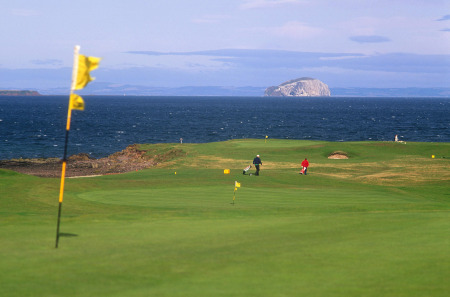Love thy neighbour - Scotland awaits

The next European staging of the Ryder Cup is four long years away but hosts Scotland are already promoting the PGA Centenary Course at Gleneagles as one of its signature courses.
The controversial choice for the 2014 matches - described as being “originally designed by Jack Nicklaus” - is named alongside such luminaries as Prestwick and Musselburgh Links.
But in fairness to the good people at Visit Scotland in their promotion of autumn golf across the Irish Sea, they also point to hidden gems such as Dunbar, Ladybank and Royal Aberdeen as a good reason to part with your hard-earned euro.
You can find details of what awaits here. But if that’s not enough to persuade you, remember the history that lies in store.
The History of Golf in Scotland
Golf is as integral a part of Scotland today as it was as far back as the 15th century when, the game of ‘gowf’, as it was known in those days, was banned by Parliament under King James II as a distraction from military training. Fortunately the ban was lifted when the Treaty of Glasgow came into effect in 1502 and the game has gone from strength to strength ever since.
Records show that golf was played at Scotland’s (and in fact the world’s) oldest course, Musselburgh Links, The Old Course, as early as 1672. However it is claimed that Mary Queen of Scots played the game as early as 1567.
Development of the modern game
Between 1750 and 1850, golf developed into the game as we know it today with the establishment of some of the world’s most prominent golf clubs. On 7 March 1744, the Honourable Company of Edinburgh Golfers, the world’s oldest golf club, which now resides at Muirfield, officially came into being at Leith Links. In the same year they drafted the first 13 rules of golf to compete for a silver golf club, presented by the City of Edinburgh, over Leith Links.
Origins of the ‘Royal & Ancient’
This set a precedent for future golf competitions and on 14 May, 1754, 22 ‘Noblemen and Gentlemen’ formed the Society of St Andrews Golfers and contributed to a silver club to be played for annually over the Links of St Andrews. St Andrews golfers adopted the rules of their counterparts in Leith and 20 years later changed their name to the Royal & Ancient Golf Club of St Andrews. The R&A is now the rulemaking body for golf throughout the world, apart from the USA and Mexico.
Over the next century a number of events took place in St Andrews which encouraged the evolution of the game. In 1764, the Links, which later became known as the Old Course, was reduced from 22 holes to 18 and that gradually became accepted as the standard format for golf courses. The “gutta percha” ball was developed in the town by Robert Paterson and its durability encouraged the development of iron-faced clubs and so continued the process of evolution.
The evolution of the game
A key figure in developing the game in St Andrews and Scotland was Old Tom Morris. To this day, he holds the British Open record for oldest champion at the age of 46 in 1867 and greatest margin of victory, 13 in 1862. But he is equally well remembered for his pioneering work in course architecture. Credited with inventing the dogleg, his contribution in Scotland included many of the world’s best-known courses such as the Old and New Courses in St Andrews, Carnoustie, Nairn and Royal Dornoch.
James Braid
Scotland’s next true giant to emerge in course design was James Braid. Born in Earlsferry, Fife, in 1870, Braid became a professional golfer in 1896, pioneered the use of aluminium-headed putters and became one of the ‘Great Triumvirate’ who would dominate British golf in the early years of the 20th century. Braid followed in the footsteps of Old Tom Morris to become a legend in course design. He was responsible for more than 250 courses throughout the British Isles including the world-famous King’s and Queen’s Courses at Gleneagles.
The first Open in 1860
The evolution of golf progressed quickly in Scotland and in 1860 the first British Open Championship was held at Prestwick, contested by eight leading professionals. The first winner was Willie Park for which he received a red Morocco leather belt with silver clasps as the first prize. The Open continued to be held at Prestwick for 11 years.
Scotland’s Signature Courses
Gleneagles, PGA Centenary
Originally designed by Jack Nicklaus, the PGA is probably one Scotland’s most famous golf courses and has been described as a modern classic. Set in the heart of Scotland, Nicklaus describes the course as “The finest parcel of land in the world I have ever been given to work with”.
Prestwick
This course in Ayrshire holds a special place in golfing history; it was the venue for the first ever Open Championship back in 1860. Although it hasn’t held an Open since 1925 this course is particularly loved due to its often unique test of golf. The first tee is located beside Prestwick Station and the railway line runs down the right hand side of the opening hole, making for a very different and unusual experience for any golfer.
Musselburgh Links
Musselburgh Links is the officially the oldest golf club in the world. Evidence has shown that golf was played on this course as far back as 1672, although it is suggested that Mary Queen of Scots played golf here in 1567. You can experience the delights of this famous 9-hole course with hickory or modern clubs.
Hidden Gems
As well as these famous courses and clubs, Scotland offers plenty of spectacular hidden gems which are definitely worth a visit.
Dunbar
The site where this course lies is said to be the place where Oliver Cromwell chose as a rest place for his troops before the Battle of Dunbar in 1650. The course occupies a thin strip of links land, alongside an exposed and rocky beach. The quality of the challenge is revealed in the number of important Scottish Championships that have been played here over the years, including the Scottish Amateur and Professional Championship.
Ladybank
Founded in 1897, this rugged course is set amongst heather, pine trees and silver birch and presents a serious test of accuracy off the tee and precision to access many of the tight and firm greens. Although the course’s definition has changed dramatically over the past hundred years, its character has remained intact. The greens on this course are compact and your approach shot requires accuracy to find the putting surface.
Royal Aberdeen
This course is located only a mile outside the city of Aberdeen and is one of the most testing and spectacular of all the great links courses in Scotland. The impressive layout is the product of the imagination and genius of Scot James Braid, a legendary course designer. Royal Aberdeen has several claims to fame, not the least of which being that it was here, in 1783, that the rule which allows only five minutes to look for a lost golf ball was established.





